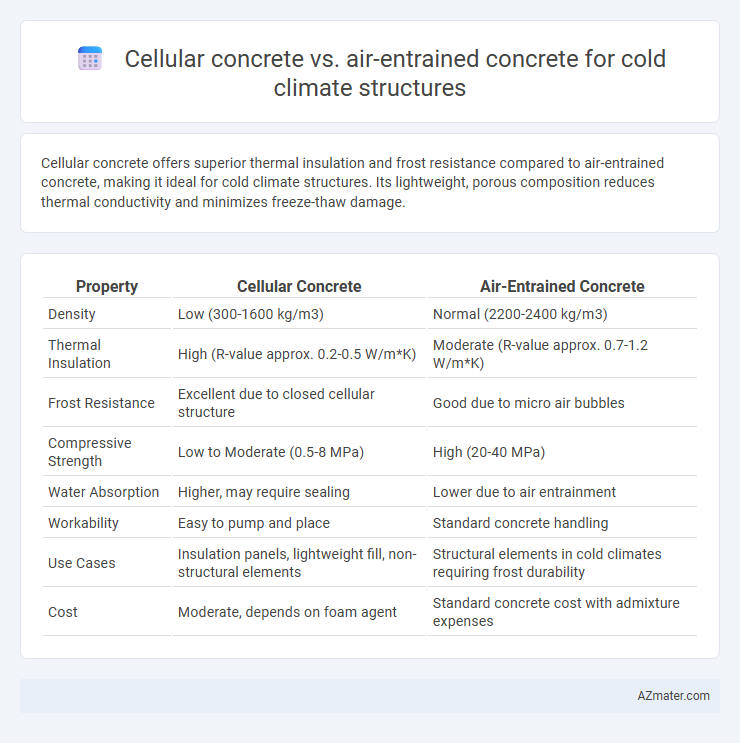Cellular concrete offers superior thermal insulation and frost resistance compared to air-entrained concrete, making it ideal for cold climate structures. Its lightweight, porous composition reduces thermal conductivity and minimizes freeze-thaw damage.
Table of Comparison
| Property | Cellular Concrete | Air-Entrained Concrete |
|---|---|---|
| Density | Low (300-1600 kg/m3) | Normal (2200-2400 kg/m3) |
| Thermal Insulation | High (R-value approx. 0.2-0.5 W/m*K) | Moderate (R-value approx. 0.7-1.2 W/m*K) |
| Frost Resistance | Excellent due to closed cellular structure | Good due to micro air bubbles |
| Compressive Strength | Low to Moderate (0.5-8 MPa) | High (20-40 MPa) |
| Water Absorption | Higher, may require sealing | Lower due to air entrainment |
| Workability | Easy to pump and place | Standard concrete handling |
| Use Cases | Insulation panels, lightweight fill, non-structural elements | Structural elements in cold climates requiring frost durability |
| Cost | Moderate, depends on foam agent | Standard concrete cost with admixture expenses |
Understanding Cellular Concrete: Composition and Properties
Cellular concrete consists of cement, water, and a stable foam that introduces numerous small, uniformly distributed air bubbles, resulting in a lightweight material with excellent thermal insulation properties. Its low density and closed-cell structure improve freeze-thaw resistance and reduce the risk of cracking in cold climate structures. Compared to air-entrained concrete, cellular concrete offers enhanced insulation and fire resistance, making it highly effective for energy-efficient building envelopes.
Overview of Air-Entrained Concrete: Key Characteristics
Air-entrained concrete contains microscopic air bubbles uniformly distributed within the mix, enhancing its resistance to freeze-thaw cycles common in cold climates. These air voids provide space for water to expand when frozen, reducing internal pressure and minimizing cracking and scaling. Its durability, improved workability, and enhanced resistance to deicing chemicals make air-entrained concrete a preferred choice for cold climate structures.
Insulation Performance in Cold Climates
Cellular concrete provides superior insulation performance in cold climates due to its high air void content, which reduces thermal conductivity and enhances energy efficiency in structures. In contrast, air-entrained concrete is primarily designed to improve freeze-thaw durability by entrapping microscopic air bubbles but offers less effective insulation compared to cellular concrete. The lower density and thermal resistance of cellular concrete make it a preferred choice for cold climate structures aiming to maintain internal warmth and reduce heating costs.
Freeze-Thaw Resistance: Cellular vs Air-Entrained
Cellular concrete exhibits superior freeze-thaw resistance due to its uniformly distributed entrained air bubbles that act as pressure relief sites, reducing internal stresses during freezing cycles. Air-entrained concrete also provides freeze-thaw protection by incorporating microscopic air pockets that prevent moisture expansion damage, though its effectiveness depends on achieving optimal air content and bubble stability. For cold climate structures, cellular concrete's consistent pore distribution often results in enhanced durability and longevity under repetitive freeze-thaw conditions compared to conventional air-entrained mixtures.
Workability and Placement Methods
Cellular concrete offers superior workability in cold climate structures due to its lightweight, flowable consistency, facilitating easy placement through pumping or casting without extensive vibration. Air-entrained concrete improves freeze-thaw resistance but typically requires conventional mixing and placement techniques, including vibration to remove entrapped air and achieve proper consolidation. Optimizing workability and placement methods in cold climates hinges on the balance between cellular concrete's ease of application and air-entrained concrete's durability against frost damage.
Structural Strength and Load-Bearing Capacity
Cellular concrete exhibits lower structural strength and load-bearing capacity compared to air-entrained concrete, making it less suitable for cold climate structures requiring high durability under heavy loads. Air-entrained concrete incorporates microscopic air bubbles that enhance freeze-thaw resistance and maintain compressive strength, crucial for structural integrity in cold environments. The increased density and strength of air-entrained concrete provide superior load-bearing capacity, essential for stability in cold climate construction.
Moisture Resistance and Permeability
Cellular concrete offers superior moisture resistance and lower permeability compared to air-entrained concrete due to its closed-cell structure, which minimizes water absorption and enhances durability in cold climates. Air-entrained concrete contains microscopic air bubbles that improve freeze-thaw resistance but can increase permeability, allowing more moisture ingress over time. For cold climate structures requiring enhanced moisture control, cellular concrete provides better protection against water infiltration and freeze-thaw damage.
Cost Comparison: Material and Installation
Cellular concrete typically offers lower material costs due to its lightweight composition and use of air bubbles, reducing the need for heavy reinforcement in cold climate structures. Air-entrained concrete, while slightly more expensive material-wise, improves freeze-thaw resistance but involves higher installation costs due to specialized mixing requirements and curing processes. Overall, cellular concrete provides a cost-effective solution with easier installation, whereas air-entrained concrete demands higher upfront expenses to ensure durability in freeze-thaw cycles.
Environmental Impact and Sustainability
Cellular concrete offers superior thermal insulation and reduced material density, leading to lower embodied energy and carbon emissions compared to traditional air-entrained concrete, making it a more sustainable choice for cold climate structures. Air-entrained concrete improves freeze-thaw durability by incorporating microscopic air bubbles, extending structure lifespan without significantly increasing environmental footprint. Both materials contribute to energy efficiency, but cellular concrete's lightweight properties further reduce transportation emissions and resource use, promoting greener building practices in cold environments.
Best Applications for Cold Climate Structures
Cellular concrete offers superior thermal insulation and lightweight properties, making it ideal for foundation insulation and void filling in cold climate structures to reduce frost damage. Air-entrained concrete enhances freeze-thaw durability by incorporating microscopic air bubbles, which improve resistance to cracking and scaling in exterior pavements and structural elements exposed to harsh winters. Combining cellular concrete for insulation and air-entrained concrete for structural durability provides an optimized approach for cold climate construction.

Infographic: Cellular concrete vs Air-entrained concrete for Cold climate structure
 azmater.com
azmater.com